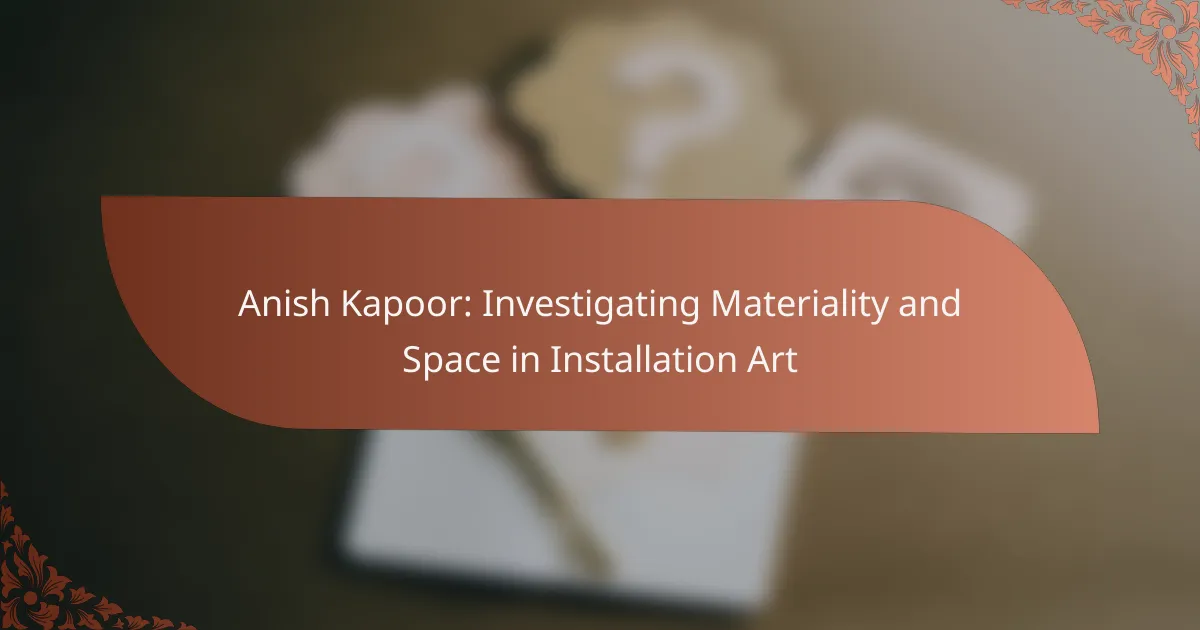Anish Kapoor’s installations challenge perceptions of space and materiality, inviting viewers to engage with their surroundings in new ways. This article explores Kapoor’s innovative use of materials like reflective surfaces, his manipulation of scale, and the cultural narratives embedded in his work. It also addresses common misconceptions about his artistic intentions and offers insights into how audiences can connect with his installations. Through these angles, Kapoor’s art emerges as a profound exploration of identity and experience.
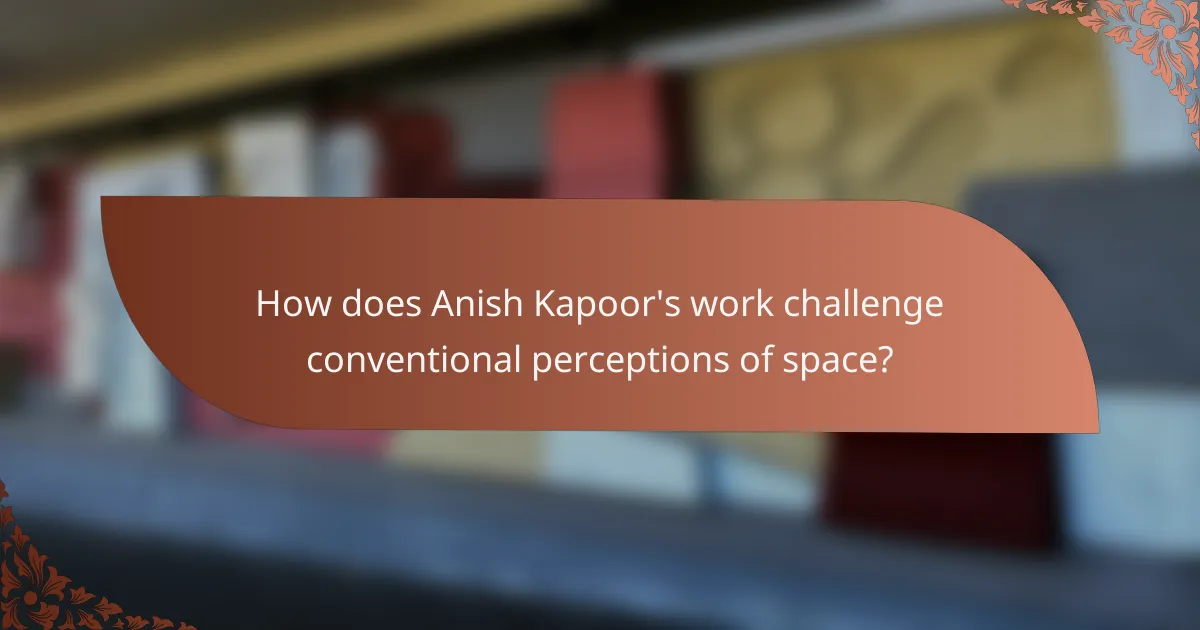
How does Anish Kapoor’s work challenge conventional perceptions of space?
Anish Kapoor’s work challenges conventional perceptions of space by transforming viewer experiences through materiality and scale. His installations manipulate light, form, and reflection to create immersive environments. For instance, the monumental “Sky Mirror” alters spatial perceptions by reflecting the surroundings, inviting viewers to reconsider their relationship with space. Kapoor’s unique use of color and texture further enhances this dialogue, making the viewer an integral part of the artwork. This approach disrupts traditional notions of static art, encouraging dynamic interactions and personal interpretations.
What techniques does Kapoor use to manipulate viewer experience?
Anish Kapoor employs techniques like scale manipulation, reflective surfaces, and immersive environments to shape viewer experiences. His use of large-scale installations creates a sense of awe, while reflective materials engage viewers in self-reflection and interaction. Kapoor’s work often alters perceptions of space, inviting audiences to explore and experience the art from different angles. These methods enhance emotional resonance and provoke thought, making the viewer an integral part of the artwork.
Why is the interplay of light and shadow significant in his installations?
The interplay of light and shadow is crucial in Anish Kapoor’s installations as it enhances the perception of depth and form. This dynamic interaction creates a sense of movement, inviting viewers to engage with the artwork from different angles. Kapoor often utilizes reflective surfaces, manipulating light to evoke emotional responses and challenge spatial boundaries. The unique qualities of his materials amplify this effect, making light and shadow integral to the overall experience of his installations.
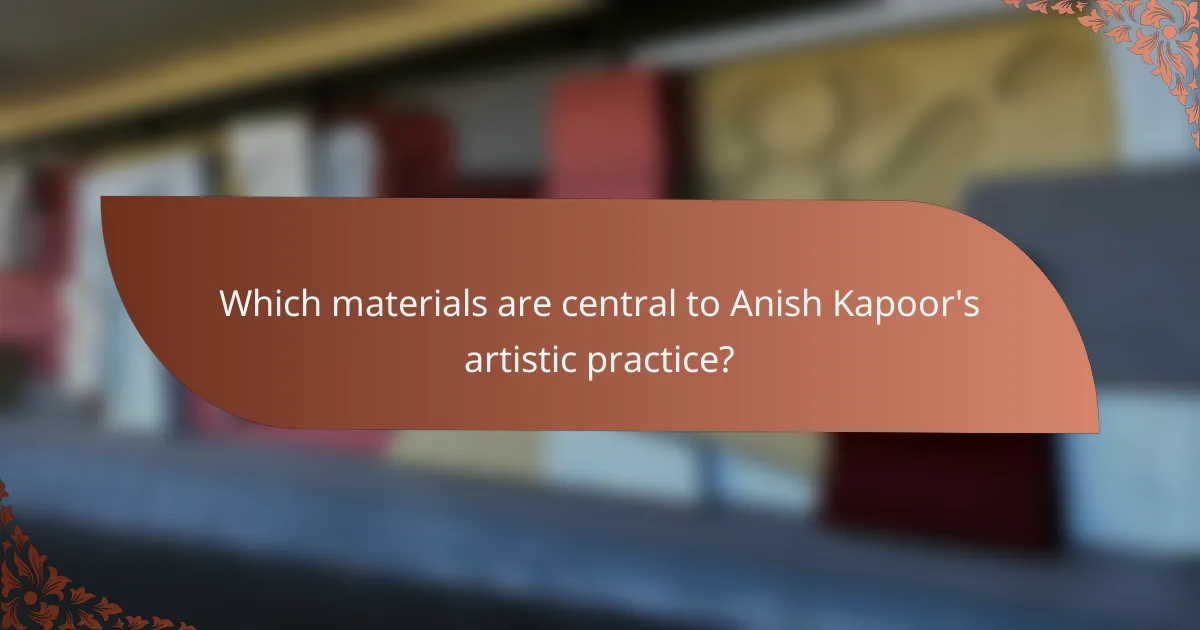
Which materials are central to Anish Kapoor’s artistic practice?
Anish Kapoor’s artistic practice centers on materials such as wax, stone, and pigment. These materials contribute to his exploration of space and perception. Kapoor often uses reflective surfaces, like polished stainless steel, to create immersive experiences. His work with biodegradable materials highlights a unique attribute, emphasizing temporality and transformation.
How do different materials influence the viewer’s interaction with his art?
Different materials significantly impact viewer interaction with Anish Kapoor’s installation art by altering perception and emotional response. For instance, reflective surfaces create a sense of infinity, while textured materials invite tactile engagement. Kapoor’s use of color and light further enhances the immersive experience, drawing viewers into a dialogue with the artwork. The choice of materials shapes not only the physical space but also the conceptual framework, influencing how audiences interpret and connect with the art.
What are the symbolic meanings behind Kapoor’s choice of materials?
Anish Kapoor’s choice of materials symbolizes various themes, including identity, spirituality, and the relationship between viewer and space. His use of reflective surfaces, such as polished stainless steel, invites introspection and engagement, while earthy materials like clay connect to human origins. Kapoor’s unique approach often emphasizes the void, challenging perceptions of absence and presence. This interplay of materials fosters a dialogue about existence and perception, making his work resonate on multiple levels.
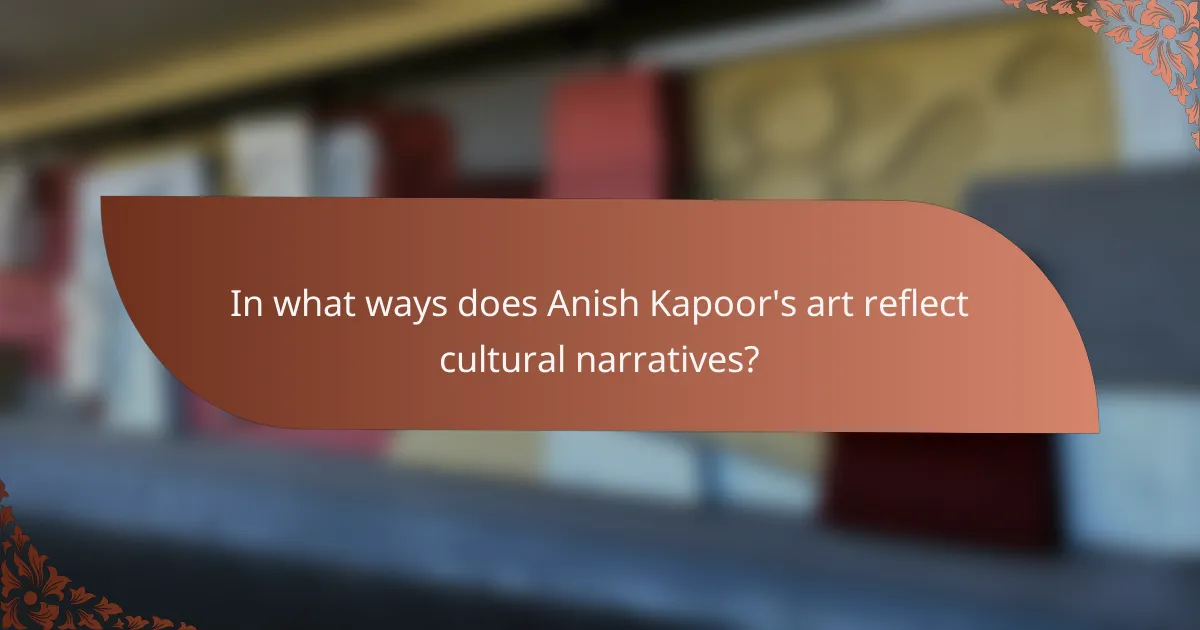
In what ways does Anish Kapoor’s art reflect cultural narratives?
Anish Kapoor’s art reflects cultural narratives through its exploration of identity, space, and materiality. His installations often engage with themes of absence and presence, inviting viewers to confront their perceptions of reality. Kapoor’s use of reflective surfaces symbolizes introspection and cultural self-examination. The interplay of light and shadow in his work evokes a dialogue between individual experience and collective memory. His pieces, like “Cloud Gate,” serve as cultural landmarks, fostering community interaction and dialogue. Through these elements, Kapoor’s art transcends mere aesthetics, embodying deeper cultural meanings and reflections.
How does Kapoor address themes of identity and belonging?
Anish Kapoor explores themes of identity and belonging through immersive installations that invite personal reflection. His use of materials, such as reflective surfaces, creates a dialogue between the viewer and the artwork. This interaction fosters a sense of connection, emphasizing shared experiences and collective memory. Kapoor’s works often challenge perceptions of space, prompting audiences to reconsider their place within it. Through these artistic strategies, he deepens the understanding of identity as a fluid and evolving concept shaped by context and environment.
Which cultural influences are evident in his installation works?
Anish Kapoor’s installation works reflect diverse cultural influences, notably Indian heritage and Western contemporary art. His use of materials, such as pigment and reflective surfaces, often symbolizes spiritual and cultural themes. Kapoor’s exploration of space encourages viewers to engage with their surroundings, highlighting the interplay between identity and environment. Additionally, his works often draw on historical narratives, integrating elements of mythology and memory.
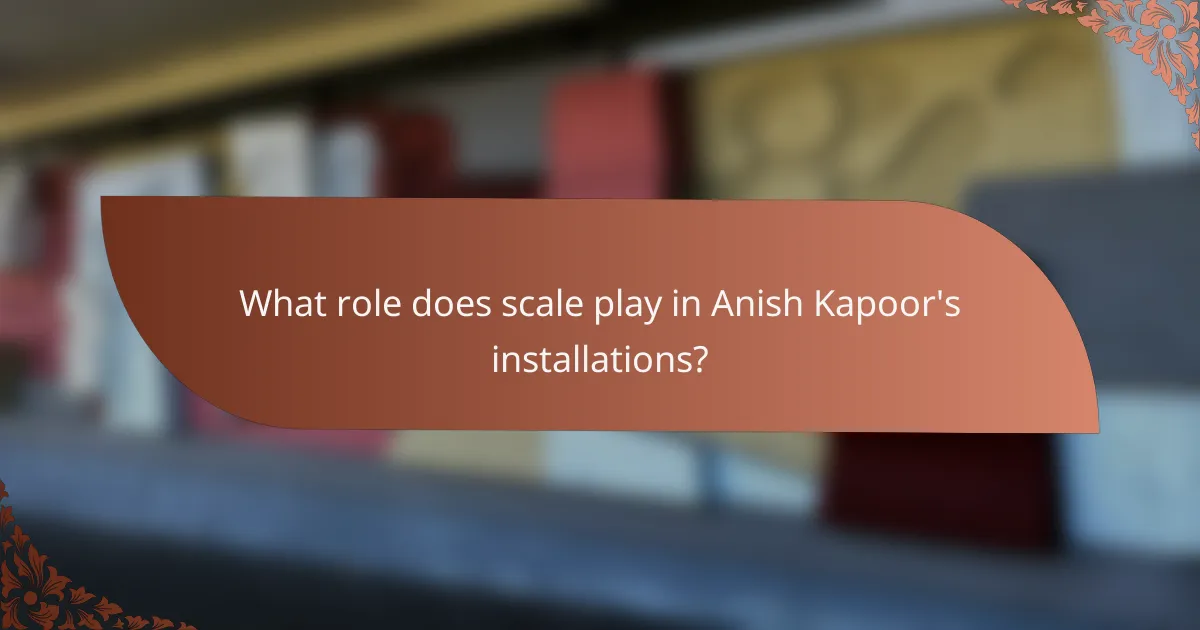
What role does scale play in Anish Kapoor’s installations?
Scale is crucial in Anish Kapoor’s installations as it alters perception and experience. Large-scale works, like “Sky Mirror,” create immersive environments that challenge viewers’ spatial awareness. This manipulation of scale enhances the materiality of his art, emphasizing the interplay between object and space. Kapoor’s unique approach invites contemplation on the relationship between viewer and installation, making scale an essential attribute of his work.
How does the scale of his works affect viewer perception and engagement?
The scale of Anish Kapoor’s works significantly enhances viewer perception and engagement. Larger installations evoke a sense of awe, inviting deeper contemplation. The immersive nature of his monumental pieces encourages viewers to navigate space, altering their emotional and physical responses. For instance, works like “Sky Mirror” create dynamic interactions with light and environment, fostering a unique connection between the artwork and the audience. This scale transforms perception, making the experience both personal and collective, as viewers share the space and engage with the artwork together.
What are the implications of large-scale installations in public spaces?
Large-scale installations in public spaces can significantly influence community engagement and cultural identity. These artworks often foster dialogue, provoke thought, and enhance the aesthetic value of their surroundings. Anish Kapoor’s installations exemplify this by utilizing materials that interact with light and space, creating immersive experiences. The unique attribute of Kapoor’s work is its ability to transform public perception of a space, encouraging viewers to reconsider their environment. As a result, these installations can serve as focal points for social interaction and cultural expression.
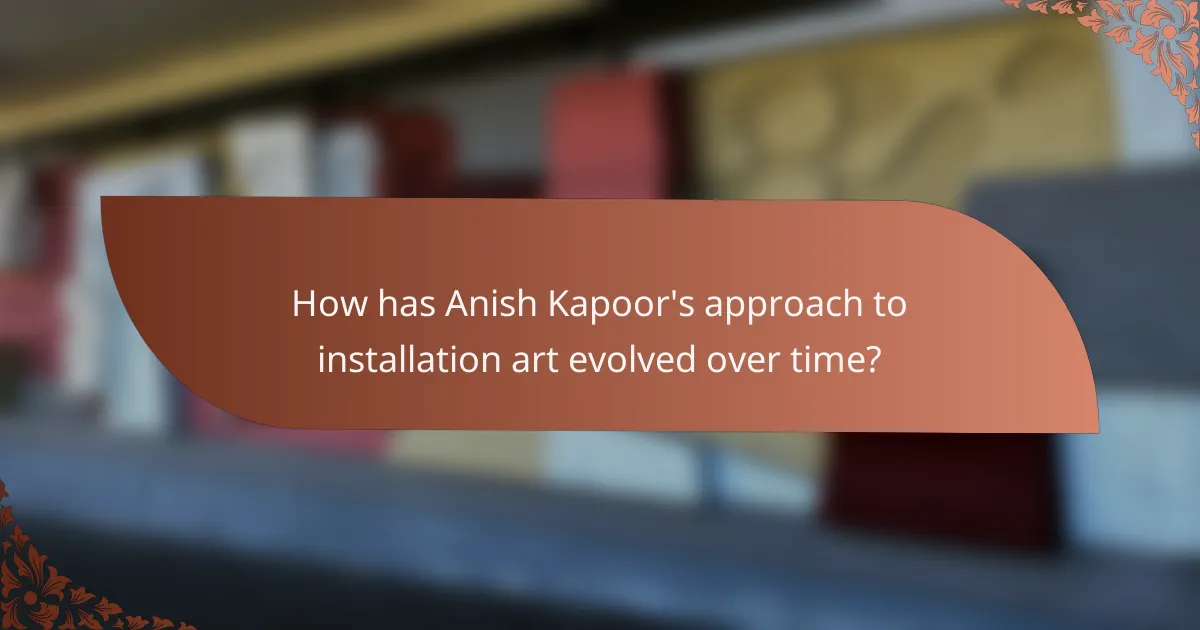
How has Anish Kapoor’s approach to installation art evolved over time?
Anish Kapoor’s approach to installation art has evolved to emphasize the interaction between materiality and space. Initially, Kapoor focused on traditional sculptural forms, but over time, he began to explore the transformative potential of materials. His use of reflective surfaces and voids creates immersive environments that challenge perceptions of space. Notably, works like “Cloud Gate” and “Sky Mirror” demonstrate his unique ability to engage viewers in a dialogue with their surroundings. This evolution highlights Kapoor’s commitment to redefining the viewer’s experience through innovative artistic practices.
What key exhibitions have marked significant shifts in his artistic direction?
Anish Kapoor’s artistic direction has shifted significantly through key exhibitions such as “Shooting into the Corner,” “Cloud Gate,” and “The Dismemberment of Jeanne d’Arc.” “Shooting into the Corner” marked a turning point with its explosive engagement with space and materiality. “Cloud Gate” showcased his ability to manipulate reflective surfaces, altering viewer perception. “The Dismemberment of Jeanne d’Arc” highlighted unique themes of identity and fragmentation, pushing boundaries in installation art. These exhibitions collectively illustrate Kapoor’s evolving exploration of form and viewer interaction.
How do recent works compare to his earlier installations?
Recent works by Anish Kapoor showcase a greater emphasis on materiality and spatial interaction compared to earlier installations. His later pieces often incorporate innovative materials and techniques that challenge viewer perceptions. For instance, the use of reflective surfaces in works like “Sky Mirror” contrasts with the more traditional forms seen in earlier pieces. This evolution reflects Kapoor’s unique attribute of continuously exploring the relationship between space and viewer engagement. Additionally, recent installations often address contemporary themes, enhancing their relevance in today’s art discourse.
![]()
What are the unique attributes of Anish Kapoor’s most iconic installations?
Anish Kapoor’s most iconic installations feature unique attributes such as reflective surfaces, immersive spatial experiences, and the interplay of light and shadow. Notable works include “Cloud Gate,” which uses polished stainless steel to create an engaging interaction with the environment. “The Sky Mirror” exemplifies his focus on reflection, altering perceptions of space. Kapoor’s installations often evoke emotional responses, challenging viewers’ perceptions of scale and form. His innovative use of materials, like wax and pigment, adds depth to the sensory experience.
Which works exemplify his innovative use of form and space?
Anish Kapoor’s works that exemplify his innovative use of form and space include “Cloud Gate,” “The Sky Mirror,” and “Descent into Limbo.” These installations manipulate physical space and viewer perception, creating immersive experiences. “Cloud Gate” reflects the city skyline, while “The Sky Mirror” alters light and atmosphere. “Descent into Limbo” invites exploration of voids, challenging spatial boundaries. Each piece showcases Kapoor’s unique ability to transform environments through sculptural innovation.
How do these installations challenge the boundaries of traditional art forms?
Anish Kapoor’s installations redefine traditional art forms by engaging with materiality and spatial experience. His works often challenge perceptions of scale, depth, and viewer interaction. For example, the reflective surfaces in “Cloud Gate” create a dynamic dialogue between the sculpture and its environment, inviting viewers to reconsider their surroundings. This innovative approach blurs the lines between sculpture and architecture, emphasizing the relationship between art and space. Kapoor’s unique use of materials, such as pigment and polished surfaces, further distinguishes his installations, making them immersive experiences that invite contemplation and exploration.
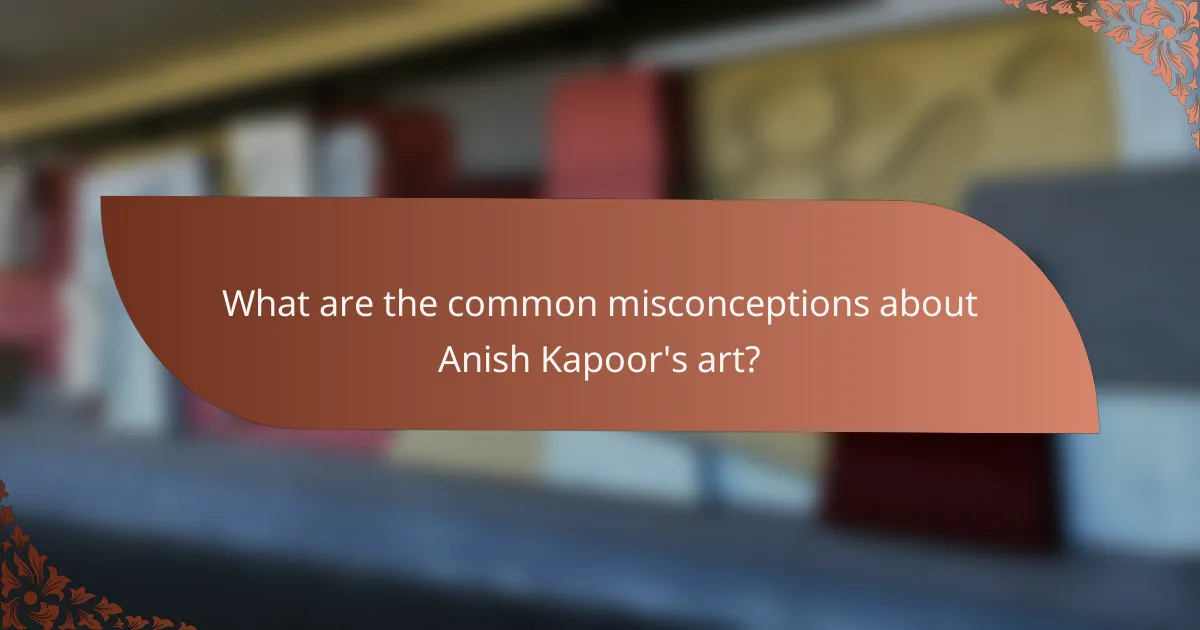
What are the common misconceptions about Anish Kapoor’s art?
Many misconceptions surround Anish Kapoor’s art, often focusing on misinterpretations of his intentions and materials. Critics sometimes perceive his work as merely decorative or simplistic, overlooking the profound exploration of space and perception. Another common misunderstanding is the belief that his installations are purely about visual aesthetics, while they often engage with deeper philosophical questions about existence and experience. Additionally, some audiences mistakenly think his use of materials, like reflective surfaces, is solely for spectacle, rather than a deliberate choice to challenge viewers’ interactions with the artwork.
How do critics interpret the meaning behind his installations?
Critics interpret Anish Kapoor’s installations as explorations of materiality and spatial perception. They often emphasize his use of unconventional materials, such as reflective surfaces and pigments, to challenge viewers’ experiences of space. Kapoor’s work invites contemplation on the relationship between the viewer and the artwork, creating immersive environments that provoke emotional and intellectual responses. The unique attribute of his installations lies in their ability to manipulate light and form, leading to varied interpretations based on individual perspectives. Critics highlight that this interplay between material and perception is central to understanding the deeper meanings behind his art.
What misunderstandings arise regarding the accessibility of his work?
Misunderstandings about Anish Kapoor’s work often stem from perceptions of exclusivity and complexity. Many believe his installations are inaccessible due to their scale and abstract nature. This view overlooks the emotional and sensory experiences they offer. Kapoor’s unique use of materials, like reflective surfaces and vibrant colors, invites viewer interaction. Some critics argue that his art is elitist, yet it encourages dialogue across diverse audiences. As a result, the accessibility of his work is often misinterpreted, limiting appreciation of its profound impact on space and materiality.
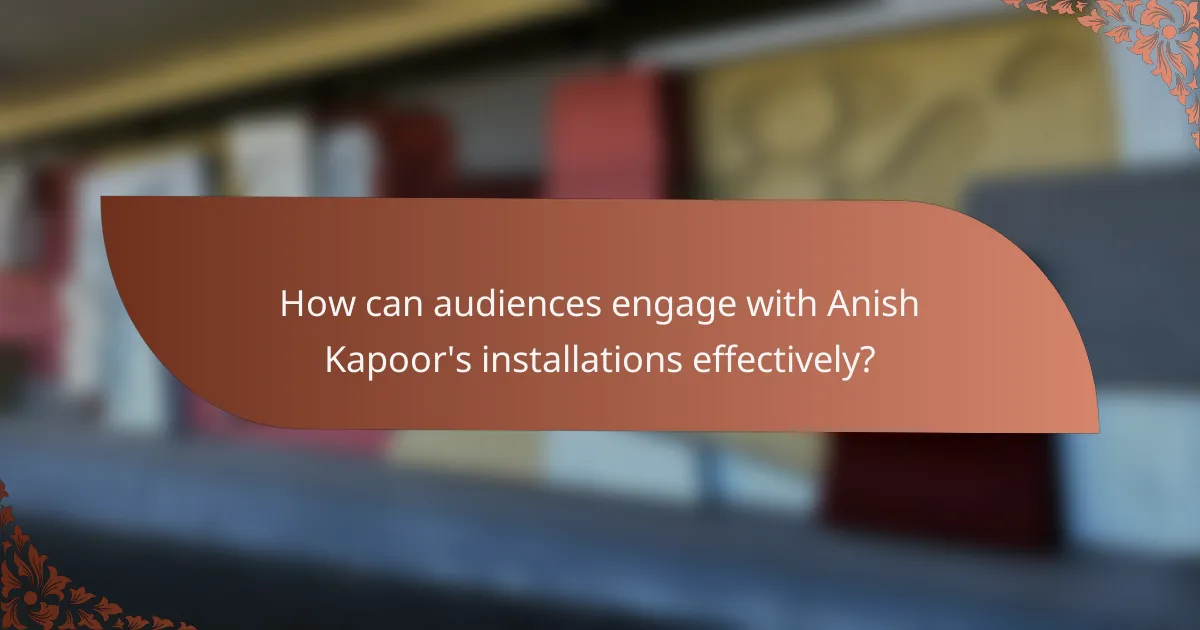
How can audiences engage with Anish Kapoor’s installations effectively?
Audiences can engage with Anish Kapoor’s installations by immersing themselves in the material and spatial dynamics he creates. Observing the interplay of light and shadow enhances understanding of his work. Visitors should consider the emotional responses elicited by the installations, as they often provoke introspection and dialogue. Participating in guided tours or discussions can deepen appreciation, offering insights into Kapoor’s concepts of void and presence. Engaging with the art physically, by moving around the installations, allows for a personal interpretation of their scale and form.
What are the best practices for experiencing his art in person?
To fully appreciate Anish Kapoor’s art in person, engage with the installation’s scale and materiality. Observe how light interacts with surfaces, enhancing spatial perception. Take time to experience the work from multiple angles, as perspectives shift meaning. Participate in guided tours for deeper insights into Kapoor’s concepts and techniques.
Which common mistakes should visitors avoid when interacting with his works?
Visitors should avoid several common mistakes when interacting with Anish Kapoor’s works. First, they should not overlook the importance of spatial context, as his installations often engage with their surroundings. Second, failing to consider the materiality of the artworks can lead to a superficial understanding of their significance. Third, visitors should avoid rushing through the experience; taking time to reflect enhances appreciation. Lastly, ignoring the emotional responses elicited by the works can diminish the overall impact of the installation art.
